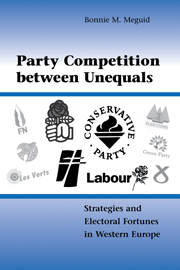Book contents
- Frontmatter
- Contents
- List of Tables and Figures
- List of Abbreviations and Acronyms
- Acknowledgments
- 1 THE NICHE PARTY PHENOMENON
- 2 POSITION, SALIENCE, AND OWNERSHIP: A STRATEGIC THEORY OF NICHE PARTY SUCCESS
- 3 AN ANALYSIS OF NICHE PARTY FORTUNES IN WESTERN EUROPE
- 4 A THEORY OF STRATEGIC CHOICE
- 5 STEALING THE ENVIRONMENTAL TITLE: BRITISH MAINSTREAM PARTY STRATEGIES AND THE CONTAINMENT OF THE GREEN PARTY
- 6 “THE ENEMY OF MY ENEMY IS MY FRIEND”: FRENCH MAINSTREAM PARTY STRATEGIES AND THE SUCCESS OF THE FRENCH FRONT NATIONAL
- 7 AN UNEQUAL BATTLE OF OPPOSING FORCES: MAINSTREAM PARTY STRATEGIES AND THE SUCCESS OF THE SCOTTISH NATIONAL PARTY
- 8 CROSS-NATIONAL COMPARISONS AND EXTENSIONS
- 9 CONCLUSIONS: BROADER LESSONS OF COMPETITION BETWEEN UNEQUALS
- References
- Index
- Cambridge Studies in Comparative Politics
7 - AN UNEQUAL BATTLE OF OPPOSING FORCES: MAINSTREAM PARTY STRATEGIES AND THE SUCCESS OF THE SCOTTISH NATIONAL PARTY
Published online by Cambridge University Press: 25 July 2009
- Frontmatter
- Contents
- List of Tables and Figures
- List of Abbreviations and Acronyms
- Acknowledgments
- 1 THE NICHE PARTY PHENOMENON
- 2 POSITION, SALIENCE, AND OWNERSHIP: A STRATEGIC THEORY OF NICHE PARTY SUCCESS
- 3 AN ANALYSIS OF NICHE PARTY FORTUNES IN WESTERN EUROPE
- 4 A THEORY OF STRATEGIC CHOICE
- 5 STEALING THE ENVIRONMENTAL TITLE: BRITISH MAINSTREAM PARTY STRATEGIES AND THE CONTAINMENT OF THE GREEN PARTY
- 6 “THE ENEMY OF MY ENEMY IS MY FRIEND”: FRENCH MAINSTREAM PARTY STRATEGIES AND THE SUCCESS OF THE FRENCH FRONT NATIONAL
- 7 AN UNEQUAL BATTLE OF OPPOSING FORCES: MAINSTREAM PARTY STRATEGIES AND THE SUCCESS OF THE SCOTTISH NATIONAL PARTY
- 8 CROSS-NATIONAL COMPARISONS AND EXTENSIONS
- 9 CONCLUSIONS: BROADER LESSONS OF COMPETITION BETWEEN UNEQUALS
- References
- Index
- Cambridge Studies in Comparative Politics
Summary
There is a changing mood in Scotland. Every Liberal, Socialist, of which ever variety of Socialist you mean, every Conservative has changed over the last few years, and we must accept that those changes are in part a response to some of the things that the Scottish National Party have been saying.…If we do not recognise it and we do not do something about it, the Scottish National Party is sitting there, vulture-like, hairy kneed vulture-like, waiting to pounce.
And pounce it did. By the time Alistair Smith issued this warning to his fellow members of the Conservative Party in 1976, the Scottish National Party had already emerged as an unexpected and almost unstoppable force. Although it never gained a national average of more than 3 percent, its true menace is revealed in the vote percentages it obtained in Scottish seats – the seats in which it competed. Between 1970 and 1997, the SNP consistently captured more than 11 percent of the vote in Scotland, with an average vote of 18.8 percent. In the October 1974 General Election, it achieved its peak vote of 30.4 percent, just 6 percentage points shy of Labour's electoral plurality. In this same election, the ethnoterritorial party surpassed the Conservatives to become the second most popular party in Scotland. Although support for the SNP would decline somewhat in the 1980s, the party reasserted its strength on the Scottish electoral scene in the 1990s.
- Type
- Chapter
- Information
- Party Competition between UnequalsStrategies and Electoral Fortunes in Western Europe, pp. 192 - 246Publisher: Cambridge University PressPrint publication year: 2008



